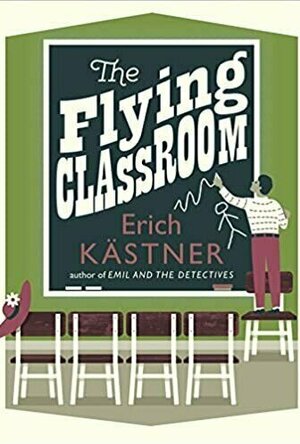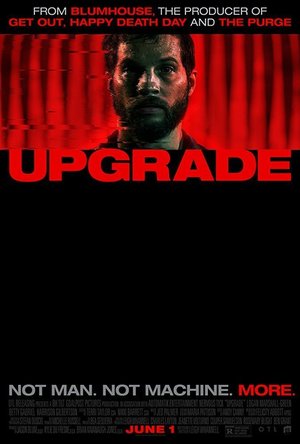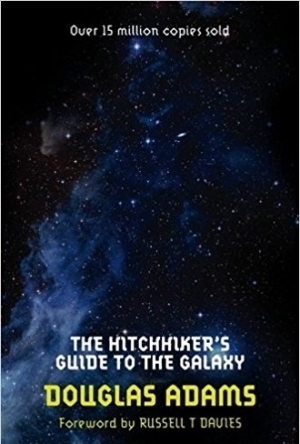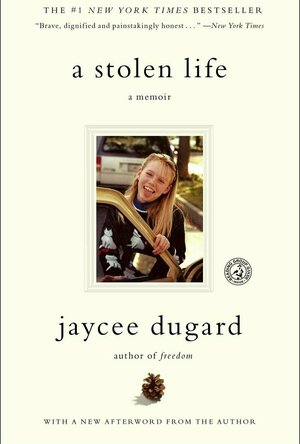
Kim Kardashian: Hollywood
Games and Entertainment
App
Join KIM KARDASHIAN on a red carpet adventure in Kim Kardashian: Hollywood! Create your own aspiring...
Daniel Boyd (1066 KP) rated Upgrade (2018) in Movies
Oct 2, 2018 (Updated Oct 3, 2018)
Well this is it.
Upgrade is a Sci-Fi movie that doesn't follow the most unique concept in the genre, but does it in such a fresh and fun way that it works incredibly well. Upgrade also does a really good job at making you feel some genuine emotions of sadness and pity, something that I really didn't expect to get from a movie like this. When it comes to the action and violence in the movie, Upgrade embraces it's B-movie inspiration and gives us some awesome grisly practical effects along with some cool action choreography to go with it.
There are some elements to the plot that may seem bizarre to those not familiar with the more campy side of this genre and the movie does slightly feel like a video game at times. However, I don't feel that this is to the movie's detriment and instead, actually adds to the fun ride that the film is taking you on.
I also like the way the movie ended, although I saw the reveal of who the big bad was going to be coming a mile away, what happened afterward was really surprising and pretty bold and risky. I don't want to spoil anything here if I can help it, but let's just say I thought that they were going one way, which would have been a really poor, cliché ending for a movie like this and then they went in totally the opposite direction, subverting expectations and instead, choosing to end the film on a genuinely unexpected note. Whether you like the ending or not, I think that the guts it took to pull it off, deserves some praise.
Overall, Upgrade is a really fun watch. It has it's high octane action sequences as advertised in the trailer and it also has some surprisingly tender, heartfelt moments to go along with all of the stunts and gore. Definitely worth a watch if you are a sci-fi fan looking for a thrilling, bloody good time.
Dana (24 KP) rated The Crown's Game (The Crown's Game, #1) in Books
Mar 23, 2018
This book was pretty cool! It is not like a lot of the other fantasy novels I read because it is set in Russia in 1825 and has some actual historical people and ideas in it. By the way, that is one of my favorite parts of this book. The fact that it is able to mix fact and fiction together so well is a feat not many can do, so I applaud Ms. Skye for doing just that.
The world felt so real and very well developed. I got the feeling that a lot of research went into creating this book and I am glad she did because it feels authentic and inhabited which is often a problem in fantasy novels such as this. Though she draws on history and fact, she understands she is able to pull in here own creative licenses because she has to make a world that will fit her story. I enjoyed those facts a lot and I am excited to see what else we will get to see in the next book (which I still need to buy).
Now onto characters, then plot.
The main character Vika is a very strong female lead, which I love in any story, not just in fantasy. She is powerful and she knows it. While this can lead to arrogance and a little too much self-esteem, but she is brought to be humbled quite a bit throughout the book, which is actually nice. It grounds her. While she is a strong character, this fact gets her into trouble sometimes because she thinks too much of herself. This arrogance is inevitably what kills her father. She is blinded by the strength she now has and, instead of questioning why she all of the sudden got so much stronger, she just rolls on without a care in the world.
I love Nikolai. In my humble opinion, he is so much better than Pasha because he opens himself up to being hurt but doesn't get angry or act like a spoiled brat when people do something wrong. Nikolai is a dreamer, something I appreciate a lot. He has his heads in the clouds sometimes and needs someone to bring him back down. While he is competitive, just like Vika, he is also very thoughtful. He could have done many things with his magic, but each time, he did something for the people, whether to bring them joy or to restore the magic of what they once knew, he does it for people other than himself. MAJOR SPOILER IS COMING UP NEXT: In his final act of the book, he gives his life to save Vika and if that isn't selfless, I don't know what is. He is caring and kind and I just wished he could have been completely happy. He loved Vika and he deserved so much more than he got. Also, that plot twist that he is the tsar's son, holy crap, I did not see that coming at all.
Now onto Pasha. I am not really a fan of Pasha, to be completely honest. He thinks he is so worthless in comparison to Nikolai even though he is going to be the tsar of Russia. Why is he making everything into a pissing match with his best friend after he finds out Nikolai also loves Vika? Seriously, he could have anyone he wanted, but no. He just has to have an enchantress. He is very selfish and does not think about how his actions will always have consequences and that is a little too reckless for me. Even though he knows he is going to become the tsar, he doesn't take his responsibility seriously at all. I am just not a fan of him. I hope he does not end up with Vika because she deserves so much more than him.
What I love most about these characters is that they have faults and issues that they have to overcome and deal with before they can move on to the next stages of their lives (well, some of them at least).
Onto the plot!
I thought this story was very well structured. I enjoyed the pacing and the flow of everything as well. It felt like it was an actual competition to see who could get my attention the most. (It was Vika and Nikolai as my top two, the others were kinda annoying at times).
Overall, I really enjoyed this book and I am excited to pick up the next one! If you have not already, give this book a read and tell me what you think!
Bong Mines Entertainment (15 KP) rated Luuv - Single by Broken Hearts Club in Music
Jun 25, 2019
“Don’t want to be here. Now I can’t see clear. This party’s starting to suck. Then you walked in slow like something magical and started changing my mind. Now every time I dream about you, you’re turning me on. But every time I think about you, it feels so wrong.” – lyrics
‘Luuv’ tells a bittersweet tale of a young guy who falls head-over-heels in love with a desirable female.
Apparently, in the beginning, all is good and well with them. He always wants to feel her lips, steal a long kiss, and see her eyes in the morning light.
But unfortunately, all good things have to come to an end, and he experiences an emotional heartbreak. Now that she’s gone, he dreams about her all of the time and can’t seem to get her out of his mind.
‘Luuv’ contains a relatable storyline, ear-welcoming vocals, and groovy instrumentation scented with an emo-indie-alternative aroma.
Also, the likable tune will be featured on Broken Hearts Club’s upcoming EP, entitled, “Make Out Music”.
“This song is about being so wrapped up in someone that you clearly know is not right for you. That you would rather be miserable having pieces of them than being happy having never known them at all.” – Broken Hearts Club
Broken Hearts Club came to life in 2019, when they bonded over their recent breakups, near-death experience, and their love of Rachael Leigh Cook and 90’s RomComs.
But instead of sulking in their pain, the duo turned their inspiration into a dream-pop world filled with songs about love and heartbreaks.
Phil Leader (619 KP) rated The Hitchhiker's Guide to the Galaxy in Books
Nov 14, 2019
I first came to the Hitchhiker's Guide series through this book. It was about 1981 I suppose and it was recommended by a school friend. I hadn't been aware of the radio series (although as luck would have it it was repeated on BBC Radio 4 within a few weeks) and it was a little while before the television adaptation appeared (which for all its faults - mainly a lack of budget - stayed true to the spirit of the books and the radio series rather more successfully than the film).
From the point I opened this and started reading I couldn't get enough Hitchhiker's Guide. Adams' style is so much like a swan on a lake - it all seems effortless on the surface but underneath there's a lot going on. As Adams' friend John Lloyd has commented, he had the ability to write backwards, so he would start with several pages of (what to other people would be) excellent material and after a couple of days' furious writing it would be down to 2 pages, but each sentence a carefully crafted gem. The result is like the difference between beer and vodka. You will enjoy drinking the beer but the distilled and concentrated vodka will knock you out.
There is real genius in the wit, ideas seemingly being pulled from nowhere and taking on a whole new aspect (towels for example). Delightful non-sequitors (especially from aliens who turn out to be pretty ordinary - or frequently less than ordinary), brilliant and inventive word play and sheer imagination and brio run through every page, all joined together by delightful asides from 'the book'.
The story itself is based on the radio series of the same name which was pretty much made up as it went along, Adams following whatever idea seemed to give him the best scope for a quick gag at the time. But somehow this all works and the story is remarkably coherent (although the book does veer away from the thread of the radio series at the very end). It has been said before that it resembles Gulliver's Travels as each new world reveals new wonders (or new banalities shining a light on our own humdrum existences here on Earth).
Oh the story? The book essentially follows one Arthur Dent, a completely unremarkable and normal human being apart from two things. Firstly his house is about to be demolished to make way for a bypass, a fact he was previously unaware of. Secondly his friend Ford Prefect (the book explains the name) is not from Guildford after all but from a small planet somewhere in the vicinity of Betelgeuse. When aliens show up to demolish the whole Earth to make way for an interstellar bypass, Ford saves Arthur from certain death and reveals he is a reporter for a book called The Hitchhikers Guide To The Galaxy and he got stuck on Earth for rather a long time.
Arthur proceeds to have a rather horrible time being shot at, thrown out of spaceships, patronised and generally baffled by everything that is going on around him. But The Hitchhikers Guide To The Galaxy is always on hand to try to explain things.
Incredibly amusing, brilliantly written and ultimately quoteable this not just a good book, it is something that really everyone should read.
Veronica Pena (690 KP) rated A Stolen Life: A Memoir in Books
Feb 5, 2020
More than anything, this memoir gives you hope. It gives you strength. It pulls your heart out to be reminded that there are these people in this world - the kind that could do this to people, let alone an 11-year-old girl. But despite all that, Jaycee remains somewhat positive. She knows that she has work to do on herself, on her relationships with her family, with the world, with life, but she also knows that she's going to be okay. I love that she never thinks that the recovery process is done and while this book was written several years ago, I can't imagine that mindset has changed much.
I think this book is phenomenal. Her story is insane, but her triumph is what wins you over in the end. I'm eager to read her other book and see where she is now and how she's doing. I would 1000% recommend this book.

The Flying Classroom
Book
A Spectator, Guardian, <Times, Independent on Sunday, Lovereading4kids and Mumsnet Book of the Year ...

Dream League Soccer - Classic
Games and Sports
App
Soccer as we know it has changed! Dream League Soccer is YOUR chance to build THE best team on the...
Kristin (149 KP) rated Awaken Me (Connected, #1) in Books
Dec 7, 2018
I really enjoyed this story, and it definitely held my interest from start to finish. Learning along with Aimee, about her past, who she actually is, about Derek and his family, was like a roller-coaster ride, and I couldn’t wait to see what happened on the next page. The supporting characters of Alec, Iva, and Marcus are all very fun to read about, as well, and I really like their interactions with one another, as well as with Aimee.
However, there were a couple times that I thought the story was rather repetitive, especially when Aimee talks about who she is, once she learns the facts. It seemed like every couple of chapters towards the end there was a “refresher course,” which would be good if you had set the book down for a while, but as I was reading it pretty much straight through, it did get slightly annoying to read the same thing over and over. It didn’t drag me down from enjoying the story, though, and I don’t think it was worth dropping a star from my rating.
All-in-all, I would definitely recommend this book to anyone who likes paranormal reads with a little revenge and romance thrown in the mix, and if you like a heroine who can kick butt, this one’s for you!
5 stars =)

Green Screen Live Video Record
Photo & Video and Productivity
App
Recording your own videos using any background has never been so easy! Thanks to Green Screen Live...




